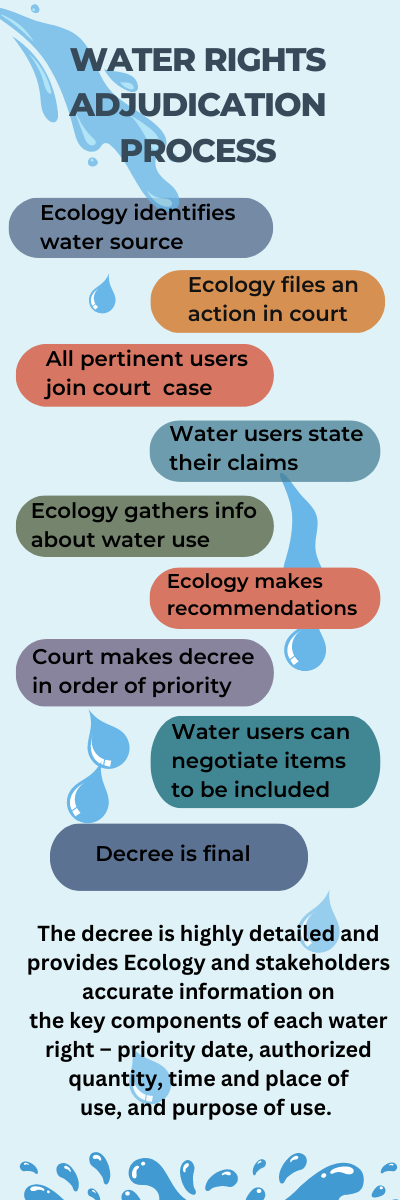Water Law and Tribal Rights
Washington passed its first water law in 1917, yet still fails to recognize the oldest water rights belong to the tribes who have made productive use of our waterways since time immemorial.
The saying, “Water is life,” became the catchphrase of the 2016-2017 protests against the construction of the Dakota Pipeline running under the primary water source of Standing Rock. The concerns about the sacredness of ancestral lands and the safety of tribal drinking water supply seemed to go largely unheard in the face of economic “progress” and corporate greed.
It was another hit in a long history of challenges tribes and First Nation peoples have faced over the health and quantity of water they have utilized for centuries.
All species – plants, animals, and humans – need water to survive. Whoever controls water – the quantity or quality – holds great power. As white settlers flooded westward, they did not care that indigenous people already resided on the lands they coveted. The lush land, abundant game, and riches in the soil and stones combined with the vast flowing waters of the west made settlers feel they’d found paradise. The belief that largely white stakeholders’ needs and industrial interests take precedence over tradition, cultural significance, and ecological health still lingers in how we set priorities for water rights.

The Winters Doctrine: The Foundation of Tribal Water Rights
Although the federal government has authority to regulate water, it usually defers to the states to allocate their own water resources unless there are water allocation issues related to federal lands – including tribal reservations.
Tribal reserved water rights were first recognized by the U.S. Supreme Court in Winters v. United States in 1908. In Winters v. US, the court found that when the federal government created the Fort Belknap reservation it implicitly reserved the rights to use a sufficient amount of the river’s water to fulfill the purposes of the reservation as a homeland for the Gros Ventre and Assiniboine people.
These “Winters doctrine” rights, now applied to tribes across the country, have a number of distinctive aspects to them.
● The rights are considered as having been established as of the date the federal government created the reservation involved. This means that tribal rights are nearly always senior to those of most other current users of Western water.
● The rights cannot be forfeited by non-use, as can the rights held under state law according to the principle of “prior appropriation.”
● Although the scope of these rights is sometimes quantified as being the amount of water necessary to support the “practically irrigable acreage” on a reservation, the rights, once quantified, can be used for non-agricultural purposes.
● The rights involve the future needs on a reservation, not just the present needs.
The Winters Doctrine is used across the county by tribes seeking to solidify their water rights through adjudication.
In Washington State, the Boldt Decision
Reaffirms Water Rights
In 1970, the federal government filed United States v. Washington on behalf of the tribes, arguing the state was denying tribes rights guaranteed in treaties signed in the 1850s – particularly those around the right to fish at all usual and customary locations. The Boldt Decision also established tribes as co-managers, established conservation standards, restricted the ability of the state to regulate treaty fishing, and affirmed that the treaty meant fish must be available.
In order for there to be fish, there must be habitable, consistent water flow in the rivers and tributaries in which salmon return to spawn and for young to grow. Without some measure of control over the off-reservation impacts to water availability, depth, flow, and overall health, tribes argue their treaty rights to fish are being adversely impacted.
Tribes in Washington have the most senior water rights because they have been in Washington State for much longer than settlers. Tribes have water rights both within and outside of their reservations. The off-reservation water rights are designated to leave enough water remaining in rivers and streams for healthy salmon populations. This water right is tied to their treaty-given right to fish, and is especially important when salmon return to spawn in the summer when water shortages are common. (ReSources)
Most tribes in Washington do not have their water rights quantified – meaning, a determination has not been made about how much water is necessary, where, and for what – because the legal system is slow to comprehend and act on the full extent of the treaty-given rights clarified in Boldt. Without quantifying off-reservation (upstream/groundwater) water rights in particular, there is no way to enforce or protect Tribal water rights, or the treaty rights to fish as determined by the Boldt decision.
Adjudication
The process of quantifying water rights is through adjudication, where by Ecology prepares a report listing all water users and presents it to the court for determination as to whose rights are senior and how much they should receive.
Currently, the only federally recognized tribe that has gone all the way through the adjudication process is the Yakima. In 2011, the Lummi Nation and Nooksack Indian Tribe requested a federal adjudication of their off-reservation water rights, but it took 10 years for Washington State to agree to the need.
In 2019, the Legislature directed the Department of Ecology “to assess and explore opportunities to resolve water rights uncertainties and disputes through adjudications in selected basins where tribal senior water rights, unquantified claims, and similar uncertainties about the seniority, quantity, and validity of water rights exist.”
At the Legislature’s direction, Ecology hired a Project Manager with expertise in water law, who reviewed watersheds around the state to determine which areas would benefit most from a court adjudication process to resolve water right uncertainties
and disputes.
The adjudication assessment agreed with the Lummi Nation and Nooksack Tribe began the adjudication process on the Nooksack watershed was instated. Additionally, the Colville Tribe and Lake Roosevelt and its middle tributaries were selected as urgent priorities.

